Formulation and development in pharmaceutical manufacturing are critical processes that ensure the efficacy, safety, and quality of pharmaceutical products. These processes involve several key stages, each contributing to the successful creation of a drug product. Here’s an overview of the steps involved:

Pre-Formulation Studies
- Drug Substance Characterization: Understanding the physical and chemical properties of the active pharmaceutical ingredient (API), including solubility, stability, and polymorphism.
- This is list itemExcipients Selection: Identifying suitable excipients (inactive ingredients) that can help in the drug's delivery and stability.

Formulation Development
- Formulation Design: Developing a formulation that ensures the API is delivered effectively. This includes selecting appropriate dosage forms (e.g., tablets, capsules, injections).
- Optimization: Adjusting formulation parameters to improve efficacy, stability, and manufacturability. This may involve changing excipients, altering concentrations, or modifying the release profile.

Pre-Clinical and Clinical Testing
- Pre-Clinical Testing: Conducting studies in animal models to assess the safety, efficacy, and pharmacokinetics of the formulation.
- Clinical Trials: Testing the formulation in human subjects through various phases (I, II, III) to confirm its safety, efficacy, and optimal dosage.

Process Development
- Scaling Up: Transitioning from laboratory-scale to pilot-scale production. This involves developing processes that can be scaled up without compromising product quality.
- Process Optimization: Refining manufacturing processes to ensure reproducibility, efficiency, and cost-effectiveness. This includes optimizing mixing, granulation, drying, and compression processes.

Validation and Quality Control
- Process Validation: Ensuring that the manufacturing process consistently produces a product meeting predefined specifications and quality standards.
- Quality Control: Implementing rigorous testing of raw materials, in-process materials, and finished products to ensure they meet quality and safety standards.

Regulatory Compliance
- Documentation: Preparing comprehensive documentation required for regulatory submissions, including data from formulation development, clinical trials, and process validation.
- Regulatory Submission: Submitting New Drug Applications (NDAs) or Marketing Authorization Applications (MAAs) to regulatory authorities (e.g., FDA, EMA) for approval.

Commercial Manufacturing
- Scale-Up: Moving to full-scale production while ensuring that the quality and consistency of the product are maintained.
- Manufacturing Operations: Implementing Good Manufacturing Practices (GMP) to ensure the product is manufactured to the highest standards.

Post-Market Surveillance
- Ongoing Monitoring: Tracking the product’s performance in the market, including monitoring adverse effects and ensuring continued compliance with regulatory standards.
- Product Improvements: Making necessary adjustments based on feedback, market conditions, or advancements in technology.
Key Considerations

Stability

Bioavailability

